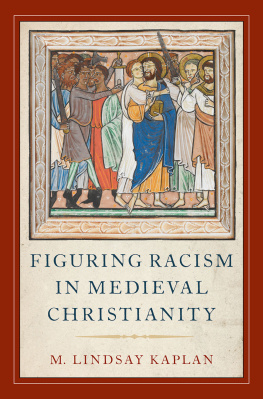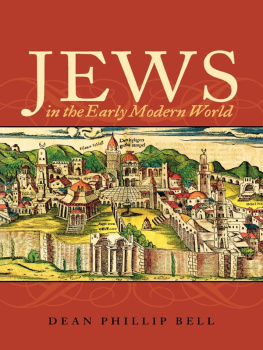Figuring Racism in Medieval Christianity

Oxford University Press is a department of the University of Oxford. It furthers the Universitys objective of excellence in research, scholarship, and education by publishing worldwide. Oxford is a registered trade mark of Oxford University Press in the UK and certain other countries.
Published in the United States of America by Oxford University Press
198 Madison Avenue, New York, NY 10016, United States of America.
M. Lindsay Kaplan 2019
All rights reserved. No part of this publication may be reproduced, stored in a retrieval system, or transmitted, in any form or by any means, without the prior permission in writing of Oxford University Press, or as expressly permitted by law, by license, or under terms agreed with the appropriate reproduction rights organization. Inquiries concerning reproduction outside the scope of the above should be sent to the Rights Department, Oxford University Press, at the address above.
You must not circulate this work in any other form and you must impose this same condition on any acquirer.
CIP data is on file at the Library of Congress
ISBN 9780190678241
This book is dedicated to my mother, Anne Wingfield Kaplan, and in memory of my other mothers Emma Burnside Willis, Doris Bryce Ingram, and Frieda Grunfeld Eisen, whose love, courage, and integrity inspire all I do.
( : )
I am HaShem your G-d, who brought you out of the land of Egypt, that you should not be their slaves.
( Leviticus 26:13 )
Contents
Bayerische Staatsbibliothek Mnchen, Clm14132, Genesis et Exodus cum glossa ordinaria fol 40v, urn: nbn:de:bvb:12-bsb00034372-2.
The British Library Board. MS Sloane 346 fol. 5r.
The British Library Board. MS Sloane 346 fol. 5v.
The British Library Board. MS Sloane 346 fol. 6r.
The British Library Board. MS Sloane 346 fol. 6v.
bpk Bildagentur / Staatsbibliothek zu Berlin / Art Resource, NY Ms.lat.fol.141 Rotulus.
The Huntington Library, San Marino, California.
the product of a Christian-Jewish marriage, I grew up in a predominately African American neighborhood of Philadelphia at an experiential intersection of blacks and Jews, adjacent to but outside of either identity. While each group seemed obviously distinct from the other, there was nevertheless for me an inexplicable space of overlap between the two. This imagined coincidence emerged not simply from the ways in which I noticed blacks and Jews relating to and sometimes identifying with each other, but also the ways in which they were perceived by white Christian US culture. Years later, after I converted to Judaism, I began to explore in my scholarly work representations of Jews and Jewish law in early modernity. I was surprised to find moments of overlap between blacks and Jews in this period as well. Influenced by the formative scholarship of Kim Hall and James Shapiro, I started investigating how early modern formulations of race that shaped views of Africans might also be considered in relation to Jews. Since discourses about black people in this period included Muslims and Africans, as well as, occasionally, Jews, it appeared that both somatic and religious conceptions produced race. This realization raised rather than resolved questions: how, exactly, did religion relate to race; what role did color play in religious identity; and what were the filiations that seemed to connect Jews to Muslims and to Africans in early modern discourses? The research I undertook for my contextual edition of Shakespeares Merchant of Veniceindicated the extent to which ideas prior to early modernity continued to shape representations of religion and race in sixteenth- and seventeenth-century England. Thus began my exploration of early and Medieval Christian texts about Jews that contributed to a racist construction of their identity. Once immersed in the study of religious others in medieval Christianity, I discovered the ways in which these earlier discourses coordinated ideas of Jews and Muslims. The rising intolerance toward Islam in the late twentieth and early twenty-first centuries










